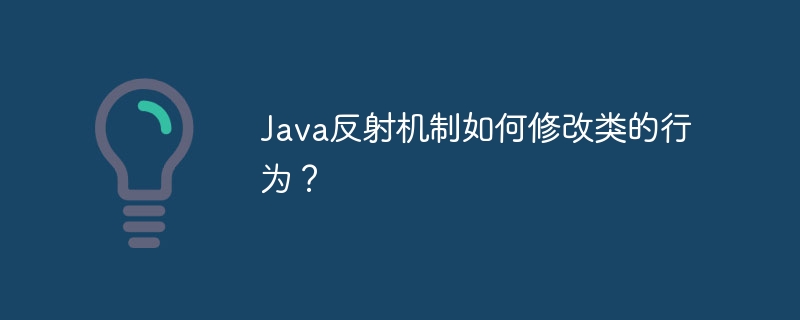Home >Java >javaTutorial >How does the Java reflection mechanism modify the behavior of a class?
How does the Java reflection mechanism modify the behavior of a class?
- 王林Original
- 2024-05-03 18:15:02561browse
The Java reflection mechanism allows programs to dynamically modify the behavior of classes without modifying the source code. By operating the Class object, you can create instances through newInstance(), modify private field values, call private methods, etc. Reflection should be used with caution, however, as it can cause unexpected behavior and security issues, and has a performance overhead.

Java reflection mechanism: modify the behavior of a class
Introduction
Java Reflection Mechanisms allow programs to access and manipulate the structure and behavior of a class. This can be used to dynamically modify the behavior of a class without modifying its source code.
Concept
The reflection mechanism operates classes through Class objects. Class The object provides access to the methods, fields, and annotations of the class. We can use the newInstance() method to create an instance of a class.
Practical case: dynamically modify field values
The following is an example of using reflection to modify field values:
public class Person {
private String name;
private int age;
}
public class Main {
public static void main(String[] args) throws Exception {
// 创建 Person 类的实例
Class<?> personClass = Class.forName("Person");
Object person = personClass.newInstance();
// 使用反射获取 name 字段
Field nameField = personClass.getDeclaredField("name");
nameField.setAccessible(true); // 设置为可访问,因为该字段是私有的
// 设置 name 字段的值
nameField.set(person, "John Doe");
// 打印修改后的值
System.out.println(nameField.get(person)); // 输出:John Doe
}
}Practical case: calling private Method
We can also use reflection to call private methods:
public class Person {
private void doSomething() { ... }
}
public class Main {
public static void main(String[] args) throws Exception {
// 创建 Person 类的实例
Class<?> personClass = Class.forName("Person");
Object person = personClass.newInstance();
// 使用反射获取 doSomething() 方法
Method doSomethingMethod = personClass.getDeclaredMethod("doSomething");
doSomethingMethod.setAccessible(true); // 设置为可访问,因为该方法是私有的
// 调用 doSomething() 方法
doSomethingMethod.invoke(person);
}
}Notes
- The reflection mechanism is a powerful tool, but should be used with caution. It may cause unexpected behavior and security issues.
- Reflection operations are subject to access permission restrictions. For example, you cannot get private fields or call private methods.
- Performance overhead: Reflection operations are slower than direct access, so their use in performance-critical code should be avoided.
The above is the detailed content of How does the Java reflection mechanism modify the behavior of a class?. For more information, please follow other related articles on the PHP Chinese website!

